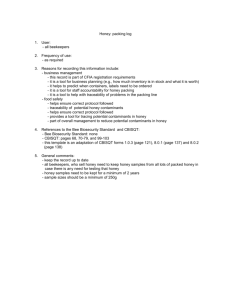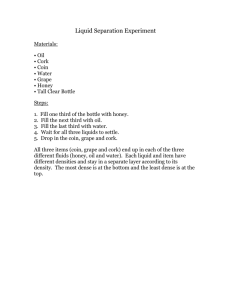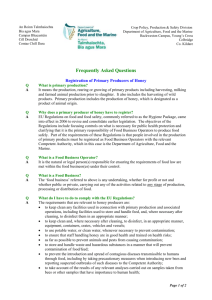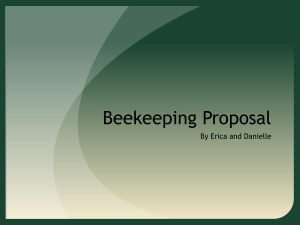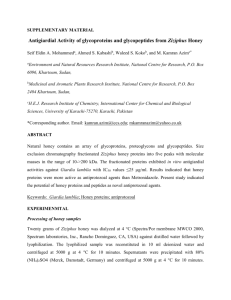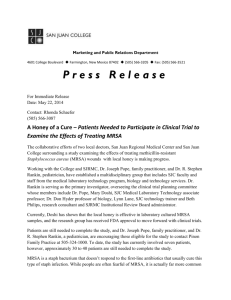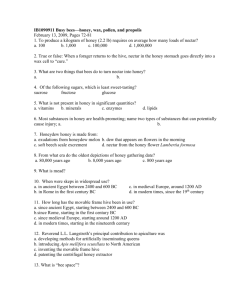Composition Criteria for Honey
advertisement
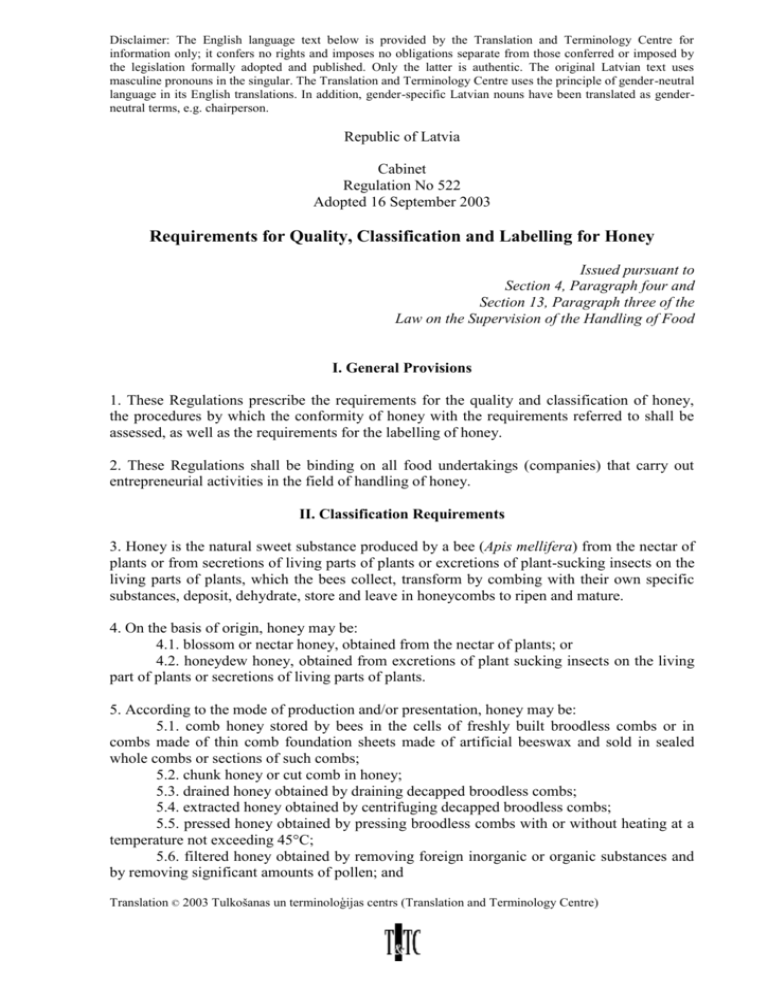
Disclaimer: The English language text below is provided by the Translation and Terminology Centre for information only; it confers no rights and imposes no obligations separate from those conferred or imposed by the legislation formally adopted and published. Only the latter is authentic. The original Latvian text uses masculine pronouns in the singular. The Translation and Terminology Centre uses the principle of gender-neutral language in its English translations. In addition, gender-specific Latvian nouns have been translated as genderneutral terms, e.g. chairperson. Republic of Latvia Cabinet Regulation No 522 Adopted 16 September 2003 Requirements for Quality, Classification and Labelling for Honey Issued pursuant to Section 4, Paragraph four and Section 13, Paragraph three of the Law on the Supervision of the Handling of Food I. General Provisions 1. These Regulations prescribe the requirements for the quality and classification of honey, the procedures by which the conformity of honey with the requirements referred to shall be assessed, as well as the requirements for the labelling of honey. 2. These Regulations shall be binding on all food undertakings (companies) that carry out entrepreneurial activities in the field of handling of honey. II. Classification Requirements 3. Honey is the natural sweet substance produced by a bee (Apis mellifera) from the nectar of plants or from secretions of living parts of plants or excretions of plant-sucking insects on the living parts of plants, which the bees collect, transform by combing with their own specific substances, deposit, dehydrate, store and leave in honeycombs to ripen and mature. 4. On the basis of origin, honey may be: 4.1. blossom or nectar honey, obtained from the nectar of plants; or 4.2. honeydew honey, obtained from excretions of plant sucking insects on the living part of plants or secretions of living parts of plants. 5. According to the mode of production and/or presentation, honey may be: 5.1. comb honey stored by bees in the cells of freshly built broodless combs or in combs made of thin comb foundation sheets made of artificial beeswax and sold in sealed whole combs or sections of such combs; 5.2. chunk honey or cut comb in honey; 5.3. drained honey obtained by draining decapped broodless combs; 5.4. extracted honey obtained by centrifuging decapped broodless combs; 5.5. pressed honey obtained by pressing broodless combs with or without heating at a temperature not exceeding 45°C; 5.6. filtered honey obtained by removing foreign inorganic or organic substances and by removing significant amounts of pollen; and Translation © 2003 Tulkošanas un terminoloģijas centrs (Translation and Terminology Centre) 5.7. baker’s honey, which is overheated, with a foreign taste or odour, has begun to ferment or has fermented, and it is suitable for industrial use as an ingredient in other foodstuffs. 6. Quality Requirements for honey shall be as follows: 6.1. according to consistency, honey is fluid, viscous, or partly or entirely crystallised; 6.2. the colour of honey varies from nearly colourless to dark brown; 6.3. the flavour and aroma vary, depending on the types of plants; 6.4. honey consists of different sugars, predominantly fructose and glucose, organic acids, enzymes and solid particles derived from honey collection; 6.5. honey has not begun to ferment and must not have an artificially changed acidity, except the case referred to in Sub-paragraph 5.7 of these Regulations; 6.6. honey must not have been heated in such a way that the natural enzymes have been either destroyed or become significantly inactive, except the case referred to in Subparagraph 5.7 of these Regulations; and 6.7. honey may not contain organic and inorganic substances that are not characteristics of the composition thereof. 7. No pollen or constituent particular to honey may be removed, except in the case referred to in Sub-paragraph 5.6 of these Regulations, as well as in cases if the foreign inorganic or organic substances must be removed. 8. Honey placed on the market or used as an ingredient in other foodstuffs shall meet the composition criteria for honey (Annex), and no food ingredients or additives may be added thereto. 9. The Food and Veterinary Service shall control conformity of honey with the requirements referred to in these Regulations. 10. When evaluating honey, conformity of the honey with the origin, mode of production and/or presentation, as well as with certain quality criteria thereof shall be determined. 11. Quality and classification criteria shall be determined within the framework of the selfcontrol system in accordance with the requirements specified in regulatory enactments regulating the handling of food. III. Labelling Requirements 12. Honey products (hereinafter – products) shall be labelled in accordance with the labelling requirements specified in regulatory enactments. 13. The product name “Medus” [Honey] shall be applied only to products that present one of the characteristics referred to in Paragraph 3 of these Regulations and it shall be used in trade to designate such product. 14. Names of the products referred to in Paragraphs 4 and 5 of these Regulations shall only apply to such products and they shall be used in trade to designate the products referred to. 15. The names of the products referred to in Paragraph 4, as well as in Sub-paragraphs 5.3, 5.4 and 5.5 of these Regulations may be replaced by the product name “Medus” [honey]. Translation © 2003 Tulkošanas un terminoloģijas centrs (Translation and Terminology Centre) 2 16. In the labelling of baker’s honey the words “Paredzēts tikai ēdiena gatavošanai” [Intended for cooking only] shall be specified in close proximity to the product name; 17. The product name (except filtered honey and baker’s honey) may be supplemented with the following information: 17.1. regarding floral or plant origin, if the product comes wholly or mainly from the relevant flowers or plants and possesses the organoleptic, physico-chemical and microscopic characteristics of the flowers and plants referred to; 17.2. regarding regional, territorial or topographical origin, if the product comes entirely from the specified place; and 17.3. regarding specific quality criteria, provided the product possesses such criteria. 18. If baker’s honey is an ingredient in a compound foodstuff, the term ”Medus” [honey] may be used instead of the product name “Rūpnieciskais medus” [baker’s honey], but in the list of ingredients the term “Rūpnieciskais medus” [baker’s honey] shall be indicated. 19. The country or countries of origin shall be indicated on the label. 20. If the product originates in several Member States of European Community (hereinafter – EC) or a third country, the indication regarding origin may be replaced with one of the following indications: 20.1. “EK valstīs ražota medus maisījums” [blend of honey produced in EC States]; 20.2. “Ārpus EK valstīm ražota medus maisījums” [blend of honey produced outside EC States]; or 20.3. “EK valstīs un ārpus EK valstīm ražota medus maisījums” [blend of honey produced inside and outside EC States]. 21. In the case of filtered honey and baker’s honey, on bulk containers, packages and trade documents the full product name shall be clearly indicated. IV. Closing Provisions 22. Paragraph 20 of these Regulations shall come into force with a special Cabinet regulation. 23. If the product in conformity with the Cabinet Regulation No. 140 of 11 April 2000, Mandatory Harmlessness and Labelling Requirements for Honey, is prepared prior to the day of the coming into force of these Regulations, the sales of such product shall be allowed until all supplies of the product have ended. 24. Cabinet Regulation No. 140 of 11 April 2000, Mandatory Harmlessness and Labelling Requirements for Honey (Latvijas Vēstnesis, 2000, No. 133/135) is repealed. Informative Reference to European Union Directives These Regulations contain legal norms arising from Directive 2001/110/EC. Prime Minister E. Repše Minister for Agriculture M. Roze Translation © 2003 Tulkošanas un terminoloģijas centrs (Translation and Terminology Centre) 3 Annex 16 September 2003 Cabinet Regulation No. 522 Composition Criteria for Honey No. Composition Criteria 2 3 1 1. Sugar content 1.1. fructose and glucose content (sum of both) 1.1.1. in blossom honey 1.1.2. in honeydew honey, in blends of honeydew and not less than 45 g/100 g blossom honey 1.2. sucrose content 1.2.1. in false acacia (Robinia pseudoacacia) honey, alfalfa not more than 10 g/100g (Medicago sativa) honey, Menzies banksia (Banksia menziesii) honey, French honeysuckle Hedysarum honey, red gum (Eucalyptus camadulensis) honey, leatherwood Eucryphia lucida, Eurcyphial milliganii honey, citrus fruit (Citrus spp.) honey 1.2.2. in lavender (Lavandual spp) honey, borage (Borago not more than 15 g/100g officinalis) honey 1.2.3. in other types of honey 2. Water content 2.1. in heather (Calluna vulgaris) honey and baker’s not more than 23 % honey 2.2. in baker’s honey obtained from heather not more than 25 % 2.3. in other types of honey not more than 20 % 3. Content of substances insoluble in water 3.1. in pressed honey not more than 0.5 g/ 100g 3.2. in other types of honey not more than 0.1 g/ 100g 4. Electrical conductivity 4.1. in honey and blends of honey 4.2. in honeydew honey and chestnut honey or in the not more than 0.8mS/cm blend of these types of honey (except strawberry tree Arbutus unedo honey, bell heather (Erica) honey, eucalyptus (Eucalyptus camadulensis) honey, lime (Tilia spp.) honey, ling heather (Calluna vulgaris) honey, manuka or jelly bush (Leptospermum) honey, tea tree (Melaleuca spp.) honey) not less than 60 g/100 g not more than 5 g/100 g not more than 0.8mS/cm Translation © 2003 Tulkošanas un terminoloģijas centrs (Translation and Terminology Centre) 4 5. Free acid 5.1. in baker’s honey not more than 80 miliequivalents of acid per 1000 grams 5.2. in other types of honey not more than 50 miliequivalents of acid per 1000 grams 6. Content of diastase activity and hydroxymethylfurfural (hereinafter – HMF) determined after processing and obtaining the blend 6.1. diastase activity (Schade scale) 6.1.1. 6.1.2. in honey with low content of natural enzymes (for not less than 3 example in citrus fruit honey) in which the HMF content does not exceed 15 mg/kg in other types of honey (except baker’s honey) not less than 8 6.2. HMF 6.2.1. in honey or blends of honey the origin of which are not more than 80 mg/kg regions of tropical climate 6.2.2. in other types of honey (except baker’s honey), not more than 40 mg/kg taking into account the requirements referred to in Clause 6.1.1 of this Annex Minister for Agriculture Translation © 2003 Tulkošanas un terminoloģijas centrs (Translation and Terminology Centre) M. Roze 5
